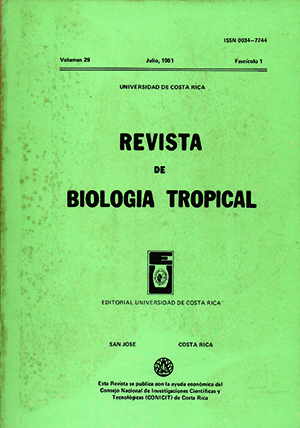Abstract
A demographic and genetic study of the Guaymi Amerindian population at Limoncito, Coto Brus, Costa Rica, showed that 47% of the population is between the ages of 0 and 14 and 35% between 15 and 44. The sex ratio is 91, which is evidence of a greater number of females. Forty percent of the couples come from Panama, but the filial generation (98%) was born in Limoncito. Emigration is very low. The selective potential is relatively high (0.94), with the mortality component predominating. Endogamy and the inbreeding coefficient have high values and polyginy is common. The effective and reproductive size of the population is small. Evolutionary implications of the results are discussed.References
Barrantes, R., P. E. Smouse, J. V. Neel, & H. W. Mohrenweiser. 1981. Migration and genetic infrastructure of the Central American GuayITÚ and their affinities with other tribal groups. Amer. J. Phys. Anthrop., (en prensa).
Bozzoli, María E. 1976. Bibliografía antropológica en Costa Rica. Universidad de Costa Rica, mimeografiado. 34 p.
Crow, J. 1958. Some possibilites for measuring selection intensities in man. Hum. Biol., 30: 1-13.
Crow, J., & M. Kimura. 1970. An introduction to population genetics theory. Harper & Row. 591 p.
Laurencich, Laura. 1968. Notas antropológicas sobre un grupo de indios Guaymí de la región sur de Costa Rica. Actas del XXXVIII Congreso de Americanistas, Stuttgart-Mnnchen, 4: 395-404.
Laurencich, Laura. 1974. Observazioni antropologiche su di un gruppo di Amerindi Guaym í di Costa Rica. Arch. Antrop. Etnol. Bologna, 104: 65-78.
Murchie, Anita, Imelda Leiva & María E. Bozzoli. 1978. Bibliografía antropológica de Costa Rica. Universidad de Costa Rica, mimeografiado. 23 p.
Neel, J. V. 1978. The population structure of an Amerindian tribe, the Yanomama, Ann. Rev. Genet., 12: 365-413.
Neel, J. V., & N . Chagnon. 1968. The demography of two tribes of primitive, relatively unacculturated American Indians. Proc. Nat. Acad. Sci. Wash., 59: 649-699.
Neel, J . V., & F. M. Salzano. 1964. A prospectus for genetic studies of the American Indian cold Spring Harbor Symposia on Quantitative Biology, XXIX: 85-98.
Neel, J. V., & F. M. Salzano. 1967. Further studies on the Xavante Indians. X. SOrne hypotheses-generalizations resulting from these studies. Amer. J. Hum. Genet., 19: 554-574.
Pérez, A. A., & F. M. Salzano. 1978. Evolutionary implications of the ethnography and demography of Ayoreo Indians. J. Hum. Evol., 7: 253-268.
Salzano, F. M. 1972. Genetic Aspects of the demography of American Indians and Eskimos, p. 234-251. In G. A. Harrison and A. J. Boyce, The structure of human populations, Oxford.
Spielman, R. S., S. Migliazza, J .V. Neel, H. Gershowitz & Reina Torres. 1979. The evolutionary relationships of populations. A study of the Guaymí and the
Yanomama. Curr. Anthrop., 20: 377-388.
Tanis, RJ., J. V. Neel, & Reina Torres. 1977. Two more "private" polimorphisms of Amerindian tribes; LDHBGUA-I and ACPBGUA-I in the Guaymi in Panama. Amer. J. Hum. Genet., 29: 419-430.
Ward, R. H., & K. M. Weiss. 1976. The demographic evolution of human populations. Academic Press. 158 p.
World Health Organization (WHO). 1968. Research on human population genetics. Technical Report Series, N° 387, Ginebra, Suiza, 32 p.
Young, P. 1970. Notes on the ethnohistorical evidence for structural continuity in Guaymí society. Ethnohistory, 17: 11-29.
Young, P. 1971. Ngawbe: Tradition and change among the Western Guaymí of Panama. Illinois Studies in Anthropology, No. 7, University of Illinois Press.
Comments

This work is licensed under a Creative Commons Attribution 4.0 International License.
Copyright (c) 1981 Revista de Biología Tropical


